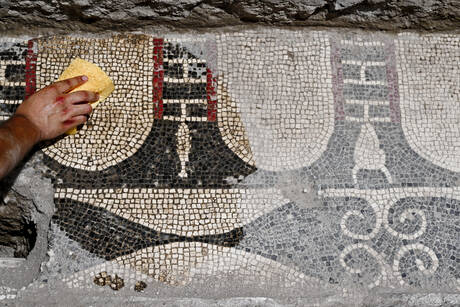The carapace almost intact, the head intact like the tail and one of the legs.
It is a small turtle of land, incredibly preserved with its never laid egg, the last surprise of Pompeii, which ANSA documents in preview.
Archaeologists found it half a meter deep under the dirt floor of a shop on the central Via dell'Abbondanza, where a research shared between
the Eastern University of Naples, the Freie Universitat of Berlin and the University of Oxford
he is investigating the remains of a luxury house which after the earthquake of 62 AD was demolished and annexed to the Stabian Baths.
"Pompeii, a treasure chest of history that fascinates the world", applauds the minister of culture
Dario Franceschini
.
This is an important find, explains the director of the Archaeological Park,
Gabriel Zuchtriegel
, "which opens a window on the last years of the city's life", those following the earthquake, "in which the whole of Pompeii was transformed into a large, pulsating building site".
In this situation, the ecosystem of the town changes, the director emphasizes, with wild animals that find their space in the premises being processed or in shops like this one, right in the center.
The tortoise had evidently entered the taberna "and there, in a protected corner, it had dug a den in which to lay its egg", notes the anthropologist Valeria Amoretti, "which she did not succeed in and which could have caused the death".
The research will now continue in the laboratory, but in the meantime, with the help in the field of the students of the Neapolitan university,
the floors and decorations of the magnificent house that originally occupied those spaces are coming to light.
A home of absolute value, they underline
Marco Giglio dell'Orientale and Monika Trumper of the University of Berlin
, which stretched over 900 square meters between halls and courtyards in a very central area of the city.
With mosaic carpets that for their complexity and beauty, the professors point out, can be compared to those of the Villa of the Mysteries or the Casa di Cerere, made precious by refined and rare designs that in some cases reproduce the wonders of Roman architecture , like the long aqueduct that appeared on the floor of the tablinum.
A wonder that the excavations of recent weeks have also returned through fragments of what it once was: polychrome marble clogs, a small, beautiful terracotta mask, even a painted shell that had to make a fine show of itself somewhere.
Unfortunately, only two fragments remain of the walls, small but of strong impact, with elaborate and colorful wall paintings in the second style, the one in vogue in the first century.
a C. And not only that: in another corner of the shop where the turtle was found, where the entrance to the domus was originally supposed to be, the archaeologists found a votive pit, basically a hole dug on the occasion of the foundation of the house, with remains of burnt woods and auspicious offerings for the gods.
A very widespread practice in the Roman world, Giglio emphasizes,
but that in Pompeii it was possible to investigate little.
Among the coals there was still the broken olla that had contained the offerings together with a small lamp.
And from this, which dates back to the beginning of the first century BC, explains Giglio, "the proof has come that this house was actually built in the first half of the first century BC".
Perhaps immediately after 80 BC, he adds, when after the siege of Silla the city suffered the shame of its transformation into a Roman colony.
The mystery remains as to who was the rich owner
: perhaps a Roman major, a senior army officer or perhaps a Pompeian who had cheered on Silla?
The professor is not unbalanced: "Certainly an eminent character of Pompeian life", he replies.
"Now we cannot say more, we hope to understand more in the next excavation campaign, in 2023".
Just as it remains to be understood why, 150 years after its construction, this splendid residence was razed to the ground.
Also in this case we can only reason on hypotheses: perhaps the earthquake had damaged it to the point of making it not very convenient to renovate it;
or perhaps, as documented in other situations in Pompeii, the fear experienced by the earthquake convinced the owners to move to a situation deemed safer.
Not to mention that the family that had founded it could have fallen into decline in the meantime.
Of course at the moment there is only that all that splendor, thanks to the prices of the real estate market that collapsed after the earthquake, passed into the property of the city administration which made it available to the spas in which it was decided to invest a lot by building a new large swimming pool. equipped with running water, spectacular nymphaeums, ultra-modern and super-technological environments for the time.
Monika Trumper, the

